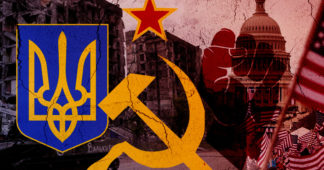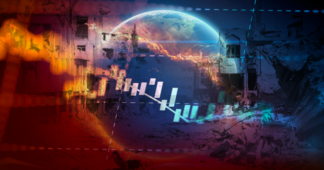By Dimitris Konstantakopoulos
March 5, 2025
First of four articles
The model of “globalization,” as a model of global capitalist domination, was based on the expansion of capitalist relations of production and distribution, along with their ideological and cultural superstructure, across most of the planet following the “collapse—suicide” of the USSR and of the “actually existing socialism” in 1989-91. It also relied on the international organization of the imposition of neoliberal economic doctrines through the Washington Consensus, free trade agreements, the lifting of most restrictions on the actions of financial capital, and the establishment of neoliberalism and monetarism, implicitly but clearly, as a constitutional principle of the EU and the Euro.
This was a model of US and capitalist global domination, heavily influenced by the ideas of Friedman and Hayek, which were exploited and “cemented” by profiteers posing as intellectuals, such as Soros, or by fantasists of poor quality and limited general culture, like Fukuyama of “the End of History.”
The “global society” was to become the field of action for international financial capital without any obstacles. This is the deeper reason why “globalization” is opposed to all strong identities that could resist the full domination of the global Empire of Finance, including traditional religions and ideologies, nations and states (at least in their democratic, national, and social functions), nationalisms (*), and even genders (**). Everything had to be fluid, except for one principle: the maximization of profit, the foundation of the new global social organization.
Behind this model lay a series of strategic assumptions by the Western ruling capitalist class:
a) That America, and more broadly the collective West, along with the dominant elites of financial capital, would secure its global domination through the power of the Western political and economic example (“Democracy” in the form of Western parliamentarism and “Markets,” i.e., the dominance of Finance and capitalist relations of production and distribution), especially given that capitalism had become, after the collapse of the Eastern bureaucratic regimes, the only model of economic and political organization nationally, regionally, and internationally.
b) That this system would be sufficiently stable within the developed capitalist countries and would ensure their dominance in competition with inferior rivals like China and the countries of the Global South (Third World). These countries would take on the role of secondary subcontractors of Western multinationals and would have to be happy with some crumbs, while the bulk of profits would return to the West.
c) That Russia, which retained the Soviet nuclear arsenal and “strategic parity” with the USA, albeit with significant losses, in 1991, being the only state capable of destroying the USA, would remain permanently in a state of a “banana republic”, a third-rate Western protectorate, as it was under Yeltsin, and perhaps even be dismembered, a prospect already examined favorably by Brzezinski in his book “The Grand Chessboard.”
d) That China would also experience, under the influence of massive foreign capital inflows and the development of Chinese capitalists, its own “perestroika” evolving into “katastroika,” i.e., the overthrow of its political regime (the rule of the CCP) and its economic system (a planned economy mainly with market methods, where strategic decisions, unlike in capitalist regimes, are made by the ruling party and not by a government that is the collective representative of the ruling bourgeois, capitalist class).
Globalization in Crisis
These assumptions, however, proved to be wrong:
A) The system proved unstable, causing massive inequalities and debts, low investment and growth, internal dysfunction, and the delegitimization of Western elites, ultimately leading to the great economic crisis of 2008, in the context of which we remain, and which increasingly tends to turn into a debt crisis of the developed capitalist countries, first and foremost the United States. In a series of developed capitalist countries (Greece, Spain, France, Britain, the USA), strong political movements of the radical or far left emerged, even if they were eventually defeated.
B) The remnants of the Soviet regime, i.e., the armed forces and security agencies of Russia, found a way to decisively influence the politics of the post-communist regime in the country and, without fully overthrowing it, especially in the economic sphere where the post-communist oligarchy and Western neoliberalism continued to dominate, nevertheless significantly limited its pro-Western orientation in foreign policy, with at least the passive support of the Russian population, which paid a huge, heavy price for the illusions of all kinds it had about the Americans and Capitalism in 1991.
Moscow thus began gradually trying to defend itself against the constant geopolitical expansion of the West into the former USSR and the constant expansion of NATO, as well as the interventions against a series of allied or at least friendly regimes to Russia from Yugoslavia to the Middle East. This Western expansion even reached the point of directly affecting the Russian populations of Crimea and Donbas in 2014, while the following year Russia responded probably by intervening itself, for the first time, in Syria. This was preceded already in 2008 by the attack of Georgia, encouraged by the USA and Israel, against Russian forces in South Ossetia. Not to mention the constant attacks of the West against Yugoslavia and a series of allied or at least friendly regimes to Russia in the Middle East from 1991.
C) The Chinese regime, having the experience of the Soviet collapse, did not collapse. It did not join financial globalization, the Chinese central bank did not submit to the IMF, the yuan did not become freely convertible, the Chinese economy remained a planned economy, where planning is done mainly with economic tools and not the administrative, almost military ones, as was the case in the USSR after the rise of Stalin, the abolition of the New Economic Policy (NEP), and the forced collectivization. The Chinese regime, although it made very large concessions to capitalism, which create a long-term risk of its overthrow, nevertheless managed to use the invested foreign Capital and not just be used by it, as was the case with most other Third World countries. China experienced, under these conditions, an exponential economic growth, became roughly the “factory of humanity,” and a major, very significant economic, technological, and increasingly military competitor to the USA.
D) We had significant resistance to American-Israeli imperialism in the Middle East, but also strong movements towards the Left in Latin America centered on Venezuela’s Chavez and Brazil’s Lula. These efforts were not always successful, but they indicated the relative instability and limitations of the global “empire” of the USA after 1989.
E) Finally, a series of middle-power countries, such as India, Indonesia, etc., gradually sought to upgrade their power and independence and reduce their political and economic dependence on the West, especially through the BRICS.
In other words, the economic, political, and ideological model of globalization ceased to function in favor of America, the “collective West” and Capitalism. The ruling classes of the West, those who hold real power on the planet, or at least a part of them must reorganize their domination on a different basis in an effort to maintain their global supremacy in order to be able to confront the new challenges and the new formidable competitors.
Notes:
The above text is based on the report of the writer to the conference on the rise of the Far Right organized by the Greek-Russian Club “Dialogos” in December 2024.
(*) The era of globalization is characterized by the criminalization of every form of nationalism and even of the national idea itself. Nationalisms and even nations are considered by the main stream ideologues of “globalization” as condemnable evidence of cultural backwardness and barbarism, without examining whether they are nationalisms of defending or of attacking and oppressive nations, i.e., outside the historical conditions in which they appear. Of course, imperialism itself has no problem “legitimizing” and using them when needed. Thus, the West has supported Croatian nationalism, inspired by the collaborators of the German Nazis Ustashis against Serbian nationalism, which reacted to the dissolution of Yugoslavia by Germany, Austria, the Vatican, and of all of the EU and NATO subsequently. They will also support Ukrainian nationalism, with its symbol and reference point the butcher of Ukrainians and Jews, Stepan Bandera, because it is directed against Russian nationalism, which is at this period a progressive force, to the extent that it resists the Western imperialist advance in the former USSR.
The history of Russian nationalism shows us how a force can play either a progressive or a reactionary role in different conditions and historical moments. Before December 1991, Russian nationalists contributed also to the dissolution of the USSR and the capitalist restoration in the former USSR. Afterwards, Russian nationalism turned into a force of resistance to the Western imperialist advance into the interior of Russia and the entire former USSR. The same ideological current, depending on the field, time, and conditions of its application, can be considered relatively reactionary or progressive. Only a “concrete analysis of a concrete situation” can allow us to take a position, i.e., to do politics.
(**) Some of these institutions also have a strong reactionary and oppressive content. This contributed to the strategic mistake made by a part of the Western left, in particular, to consider their deconstruction by globalization as necessarily progressive. But the destruction of a structure we do not like cannot by itself be progressive. The sudden collapse of the Soviet regime for example was a very bad development not because the Soviet regime itself was worth much, but because it was replaced by the jungle of the most savage neoliberal and often mafia-like capitalism. By deconstructing bourgeois nation-states, “globalization” did not lead to some form of national or international socialism but to the world of Davos, to societies unable to resist the power of Finance. What most of the Left did not understand in depth is that, after 1980 and, especially, 1989-91, we are rather in an environment of global counter-revolution than of revolution, characterized by the effort of the Big Financial Capital to deconstruct all the social and political achievements of the modern era, since Renaissance and the Enlightenment.









